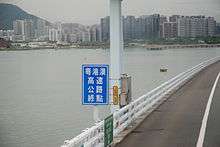Hong Kong–Shenzhen Western Corridor
| |
|---|---|
| Part of Route 10 | |
| Route information | |
| Maintained by Highways Department | |
| Length: | 5.5 km (3.4 mi) |
| Existed: | 2007 – present |
| Major junctions | |
| South end: | Tuen Mun (near Ngau Hom Shek) |
|
1 in total; Shenzhen Bay Control Point | |
| North end: | Dongjiaotou, Shenzhen |
| Location | |
| Major cities: | Hong Kong, Shenzhen |
| Highway system | |
| Hong Kong Strategic Route and Exit Number System | |
| Hong Kong-Shenzhen Western Corridor 深港西部通道 | |
|---|---|
|
Bridge at sunset | |
| Coordinates | 22°28′17″N 113°57′38″E / 22.47139°N 113.96056°ECoordinates: 22°28′17″N 113°57′38″E / 22.47139°N 113.96056°E |
| Carries | 6 lanes highway |
| Crosses | Deep Bay |
| Locale | Yuen Long, Hong Kong and Dongjiaotou, Shenzhen |
| Official name | Hong Kong-Shenzhen Western Corridor |
| Other name(s) | Shenzhen Bay Bridge |
| Characteristics | |
| Design | Cable-stayed bridge |
| Total length | 5,500 m (18,045 ft) |
| Width | 6 lanes with shoulder |
| Longest span | 210 m (689 ft) |
| History | |
| Opened | 1 July 2007 |
| Statistics | |
| Toll | 0 |
| Hong Kong–Shenzhen Western Corridor | |||||||||||
| Traditional Chinese | 深港西部通道 | ||||||||||
|---|---|---|---|---|---|---|---|---|---|---|---|
| Simplified Chinese | 深港西部通道 | ||||||||||
| |||||||||||
The Hong Kong–Shenzhen Western Corridor, colloquially known in Shenzhen as Shenzhen Bay Bridge, is a 5.5-kilometre (3.4 mi), dual three-lane carriageway in Hong Kong. It connects Ngau Hom Shek (traditional Chinese: 鰲磡石; simplified Chinese: 鳌磡石), Hong Kong to an area leased by Hong Kong at Dongjiaotou, which is geographically located in Nanshan, Shenzhen, mainland China. It connects Hong Kong with the border crossing facilities on its border with mainland China, the Shenzhen Bay Control Point.
The carriageway, together with the Kong Sham Western Highway (formerly known as Deep Bay Link), are part of the Route 10 of the Hong Kong trunk road numbering system, and part of China G4 Jinggang'ao (Beijing - Hong Kong - Macau) Expressway for the 1.6 km section north of Hong Kong - China border.
History and Operation
Construction of the highway bridge began in 2003. The 3.2-kilometre (2.0 mi), Hong Kong section was completed in 2005. The corridor was scheduled for completion in 2006 but owing to the delay in the construction of the Shenzhen section and legal issues about applying the law of Hong Kong in co-location of immigration and customs facilities of Hong Kong and mainland China in Dongjiaotou, it was officially opened on 1 July 2007 by then President Hu Jintao of China and the then Chief Executive of Hong Kong Donald Tsang.
The bridge was constructed separately by Hong Kong and mainland China, according to the maritime border. Upon its opening, the Shenzhen section of the bridge, along with the Shenzhen Bay Control Point, were leased to Hong Kong and made under Hong Kong's jurisdiction for an initial period until 30 June 2047. As such, Hong Kong laws, including traffic laws, instead of the laws of Mainland China, apply on the whole bridge and within the control point.
The biggest section of the link is the 4,770 m (15,650 ft) bridge spanning the Deep Bay. The cable-stayed bridge allows for the southern and northern navigation channels of the Sham Chun River. It can handle 58,600 vehicles and 60,000 cross-boundary tourists per day. The border crossing facilities in Dongjiaotou are separately managed by the Customs and Excise Department and Immigration Department of Hong Kong, and the China Customs.
The biggest operator of the transport corridor is the Gammon Construction-Skanska-MBEC joint venture.
Chinese and Hong Kong Immigration co-location
The Hong Kong Government has to pay rent to Shenzhen government for the use of the area, amounting to about HK$5million per year. The rental agreement lasts until 30 June 2047.[1]
Transport



Four public bus routes run on this corridor. They are operated by the New Lantao Bus Company and Citybus.
- B2 to and from Yuen Long
- B2P to and from Tin Shui Wai
- B3 and B3A to and from various location of Tuen Mun
- B3X to and from Tuen Mun (express service)
A green public light bus route, 618, also operates from Tin Shui Wai new town.
Hong Kong taxis, minibuses and cross-border buses are allowed access to the corridor; private vehicles must have the correct permit to use the corridor.
References
- "Hong Kong-Shenzhen Western Corridor". Highways Department, Hong Kong Government. Retrieved 2007-03-28.
- "Hong Kong-Shenzhen Western Corridor: Environmental Challenges From EIA Study to Construction" (PDF). Retrieved 2007-08-15.
| Wikimedia Commons has media related to Shenzhen Bay Bridge. |
| Preceded by Western Terminus |
Hong Kong Route 10 Hong Kong–Shenzhen Western Corridor |
Succeeded by Kong Sham Western Highway |
